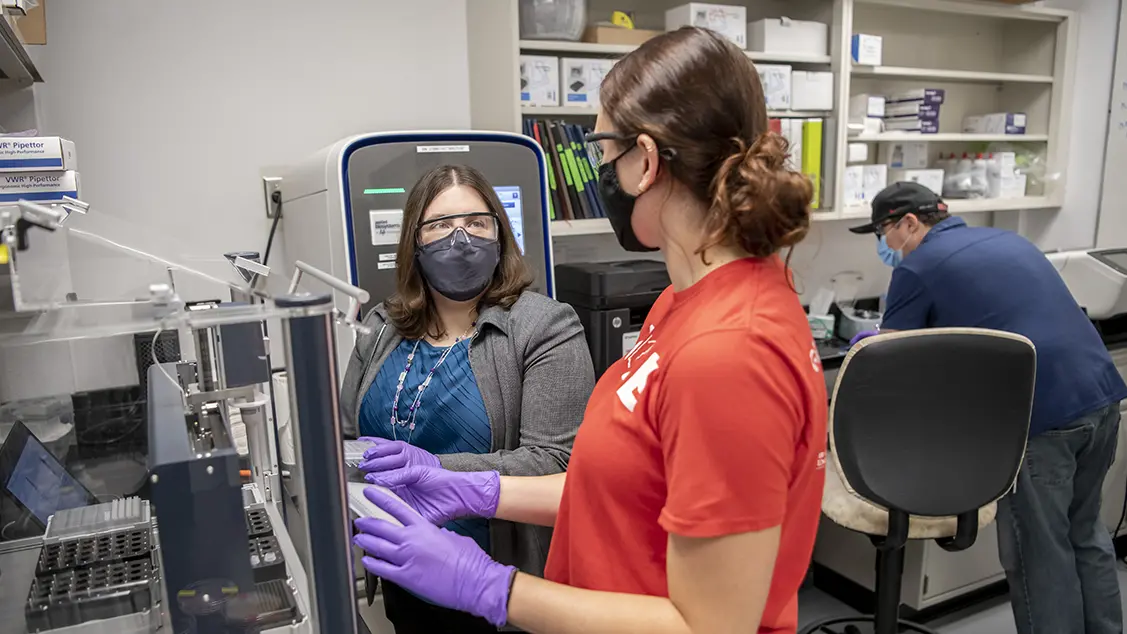Does dust in your home hold dangerous microbes?
Researcher Karen Dannemiller studies allergens, microbes and chemical contaminants to help people breathe easier while inside. Here, she answers alumni questions.

Associate Professor Karen Dannemiller has built a career at the nexus of environmental engineering and public health. (Photo by Logan Wallace)
Do you know what’s growing in your carpet? Or if mold is accumulating behind your walls? We spend 90% of our lives indoors, and exposure to dust, mold and viruses can have a huge impact on our health, especially for those living with asthma. So how do you protect yourself?
Karen Dannemiller directs Ohio State’s Indoor Environmental Quality Laboratory, which researches air quality in indoor spaces by combining cutting-edge techniques from engineering and epidemiology. Her research focuses on microbial communities in dust, which can include fungi, bacteria and viruses. Knowing how and why they grow leads to healthier living environments.
Recently, Dannemiller answered questions from alumni.
-
Our indoor spaces are cleaner than ever and continue to get even “cleaner” with the accoutrements of our wealth. Are we undermining our own immune systems by trying to protect them? — Scott Smith ’84, ’86 MA
We need to move away from the idea that all microbes in our indoor environment are harmful. Most are completely innocuous. Then there are a small number that may be helpful, and some that may be harmful.
Many of the harmful ones are the most familiar. These include pathogens that might make you sick. These should be controlled in environments where they are of particular concern, such as in healthcare settings. Additionally, harmful mold growth can occur if too much moisture is present. However, sterilizing everything all the time is not particularly helpful, and may also result in unwanted chemical exposures. Instead, we should think carefully about where harmful microbes may exist and thoughtfully control them there.
Some microbes might also be beneficial in helping our immune systems develop. The research is still ongoing, but exposures to animals in early life might help protect against development of asthma. We need continued research into the question of what constitutes a healthy indoor microbiome. Sterilizing everything is not the answer. At the same time, there is likely no need to try to increase our indoor microbial exposure for health benefits, but we may eventually be able to realize how to promote our exposure to the right microbes. For now, follow the healthy home principles outlined later on this webpage and you will be on your way to having healthy indoor microbial roommates.
-
For those of us who do not suffer from asthma, why should we worry about keeping a dust-free home? — Christina Fekter ’92
Dust can contain several different harmful contaminants — allergens, microbes and chemicals. These can be especially problematic for individuals with respiratory concerns, but they can affect us all.
Allergens can be deposited in dust from a variety of sources, including insects and animals. Cockroach allergens are a substantial problem for children with asthma. And cat allergens travel far in air — many homes without a cat have measurable levels from external sources.
Microbes originate from people, pets, outdoor air and other sources. Most are harmless, but if too much moisture is present, then fungal growth can occur and cause negative health effects.
Finally, dust can contain chemical contaminants. One example is phthalates, which leach out of the plastic things in our homes. These endocrine disruptors can hurt our health. There are also many other chemical contaminants that might be present in dust depending on the home.
Generally, it will be nearly impossible to maintain a truly dust-free home. Every time a person moves around a room, dust will be resuspended from the floor and result in exposure. This exposure can be reduced if dust is removed through regular cleaning. However, it is impossible (and also not actually that helpful) to remove all of the dust, so keep it to reasonable levels to avoid health effects. This is true for everyone, but especially those with respiratory concerns.
-
What are the five most effective ways to maintain air quality in an indoor space? — David Shell ’88
I can’t limit myself to five because there is such a nice list of eight principles supplied by the U.S. Department of Housing and Urban Development. These need to be followed collectively to maintain a healthy indoor environment:
- Keep it dry.
- Keep it clean.
- Keep it safe.
- Keep it well-ventilated.
- Keep it pest-free.
- Keep it contaminant-free.
- Keep it maintained.
- Keep it thermally controlled.
-
Is a home air purifier with HEPA filter useful for an average family household? — Mary Thompson ’80
Everyone wants a healthy indoor space, but it is important to know what actually works. Generally, there are three methods to deal with indoor contaminants.
The first and most effective is source removal. Can you remove the item that is causing the contaminant in your home? For example, if you purchased a piece of furniture that smells terrible and makes you sick, it would not make sense to keep it.
The second is increased ventilation. Can you pull more outdoor air into your home? For example, if you are painting, open the windows.
Finally, the distant third method to control indoor contaminants is an air cleaner. Some work through removal mechanisms, such as filtering a contaminant from the air with a HEPA filter. These can be effective in circumstances such as infiltration of wildfire smoke or traffic pollution. They also might help decrease airborne viral transmission, such as with COVID-19, if used in conjunction with other control measures.
Other air cleaners work by adding compounds to the air, such as ozone, to react with undesirable components. These are generally ineffective and can create new, harmful contaminants.
In summary, a HEPA air cleaner may help in particular circumstances. However, I would focus on source removal and ventilation first if possible.
-
How does one go about ridding the bathroom of mold/mildew and foul odors? — Billy Merritt ’75
The most important strategy to prevent mold growth is to control moisture.
After a shower, the relatively humidity in a bathroom becomes high. Even when it returns to normal, moisture can remain elevated on surfaces for around six hours. If you have a bathroom where someone showers in the morning and someone does at night, you can have 12 hours per day when moisture on surfaces is high enough to support fungal (mold) growth.
The key is to control moisture. In a bathroom, source removal is not practical — unless you never shower or bathe! Thus, the next best solution is increased ventilation. Can you use or install a vent fan that exhausts outdoors? Can you open a window? Make sure to fix any plumbing leaks. Also, some building materials are less likely to absorb and retain moisture, making them better choices for the bathroom.
-
Are there any at-home options for checking for mold or pathogens? — Deborah Naymick ’80
The bad news is there is no quantitative indicator associated with health outcomes that is better than the more subjective measures of seeing or smelling mold. The good news is that seeing or smelling mold are reliable indicators of a problem. If that happens, you don’t need to measure how much mold you have, just address the problem.
Many people have heard of “toxic black mold.” This refers to an unfortunate event in Cleveland in the 1990s where infants in a highly contaminated building experienced bleeding in their lungs from exposure to Stachybotrys chartarum (“toxic black mold”). While this particular species is harmful, so are many other molds of all colors. In reality, if mold is growing, it can cause harm and needs to be removed.



